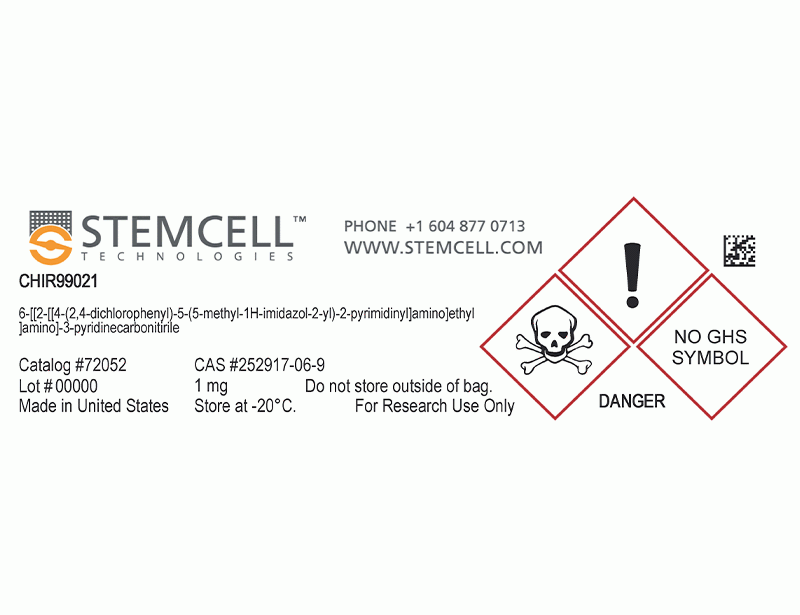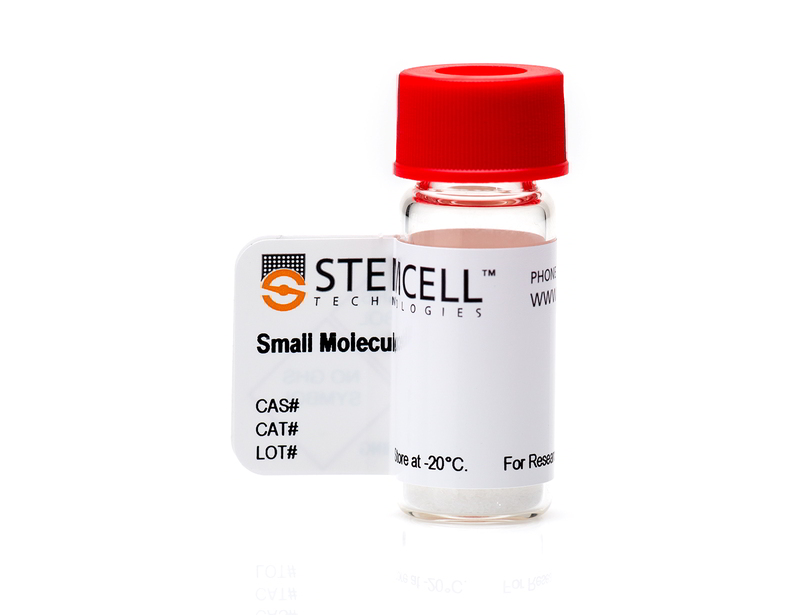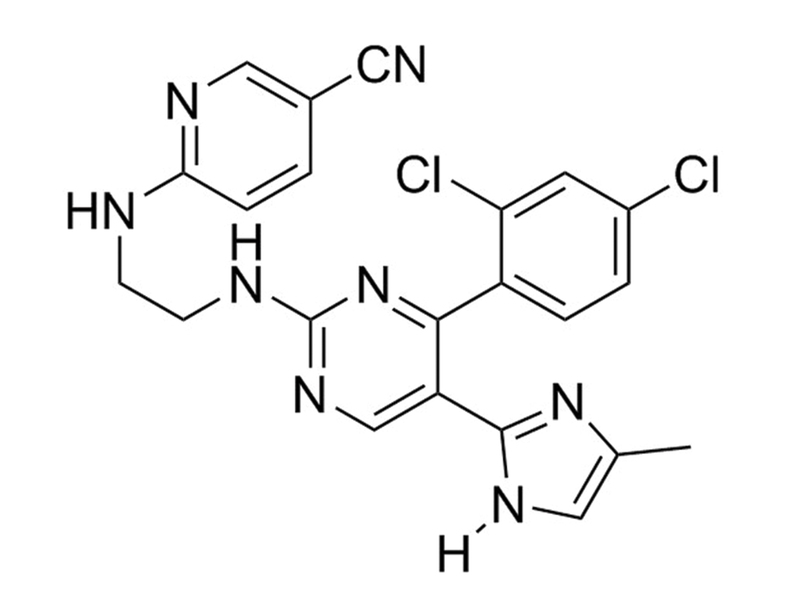概要
CHIR99021 is an aminopyrimidine derivative that is an extremely potent glycogen synthase kinase (GSK) 3 inhibitor, inhibiting both GSK3β (IC₅₀ = 6.7 nM) and GSK3α (IC₅₀ = 10 nM). GSK3 is a serine/threonine kinase that is a key inhibitor of the WNT pathway; therefore CHIR99021 functions as a WNT activator. It shows little activity against a large panel of kinases including CDK2 and other serine/threonine kinases such as MAPK and PKB (Bain et al.).
MAINTENANCE AND SELF-RENEWAL
· Maintains undifferentiated mouse ES cells in combination with PD0325901, in the absence of LIF (Ying et al.).
∙ Promotes self-renewal of human ES cells and mouse epiblast stem cells in combination with IWR-1 (Kim et al.).
∙ Allows derivation of ES cells from refractory mouse strains (Kiyonari et al., Ying et al.) and rat (Li P et al.) in combination with other small molecules.
· Maintains human and mouse hematopoietic stem cells in cytokine-free conditions, in combination with rapamycin (Huang et al.).
· Promotes growth of mouse and human intestinal stem cells (Wang et al.).
REPROGRAMMING
· Enables chemical reprogramming (without genetic factors) of mouse embryonic fibroblasts to iPS cells, in combination with Forskolin, Tranylcypromine, Valproic Acid, 3-Deazaneplanocin A, and E-616452 (Hou et al.).
∙ Promotes reprogramming of human somatic cells to iPS cells using OCT4, in combination with other small molecules (Zhu et al.).
∙ With OCT4, transdifferentiates human CD34+ hematopoietic cells to mesenchymal stem cells (Meng et al.).
· Direct lineage reprogramming of fibroblasts to mature neurons, in combination with Valproic Acid, RepSox, Forskolin, SP600125, Gö6983 and Y-27632 (Hu et al.).
· Direct lineage reprogramming of fibroblasts to mature neurons, in combination with Forskolin, ISX-9, SB431542, and I-BET151 (Li et al.).
· Generates mouse-like or “ground state” iPS cells from human and rat somatic cells, in combination with PD0325901 and A 83-01 (Li W et al. 2009).
DIFFERENTIATION
· Promotes differentiation of insulin-producing cells from human iPS cells (Kunisada et al.).
∙ Promotes differentiation of cardiomyocytes from human ES and iPS cells (Lian et al.).
∙ Generates and maintains primitive neural stem cells from human ES cells, in combination with SB431542 and Human Recombinant LIF (Li W et al. 2011).
MAINTENANCE AND SELF-RENEWAL
· Maintains undifferentiated mouse ES cells in combination with PD0325901, in the absence of LIF (Ying et al.).
∙ Promotes self-renewal of human ES cells and mouse epiblast stem cells in combination with IWR-1 (Kim et al.).
∙ Allows derivation of ES cells from refractory mouse strains (Kiyonari et al., Ying et al.) and rat (Li P et al.) in combination with other small molecules.
· Maintains human and mouse hematopoietic stem cells in cytokine-free conditions, in combination with rapamycin (Huang et al.).
· Promotes growth of mouse and human intestinal stem cells (Wang et al.).
REPROGRAMMING
· Enables chemical reprogramming (without genetic factors) of mouse embryonic fibroblasts to iPS cells, in combination with Forskolin, Tranylcypromine, Valproic Acid, 3-Deazaneplanocin A, and E-616452 (Hou et al.).
∙ Promotes reprogramming of human somatic cells to iPS cells using OCT4, in combination with other small molecules (Zhu et al.).
∙ With OCT4, transdifferentiates human CD34+ hematopoietic cells to mesenchymal stem cells (Meng et al.).
· Direct lineage reprogramming of fibroblasts to mature neurons, in combination with Valproic Acid, RepSox, Forskolin, SP600125, Gö6983 and Y-27632 (Hu et al.).
· Direct lineage reprogramming of fibroblasts to mature neurons, in combination with Forskolin, ISX-9, SB431542, and I-BET151 (Li et al.).
· Generates mouse-like or “ground state” iPS cells from human and rat somatic cells, in combination with PD0325901 and A 83-01 (Li W et al. 2009).
DIFFERENTIATION
· Promotes differentiation of insulin-producing cells from human iPS cells (Kunisada et al.).
∙ Promotes differentiation of cardiomyocytes from human ES and iPS cells (Lian et al.).
∙ Generates and maintains primitive neural stem cells from human ES cells, in combination with SB431542 and Human Recombinant LIF (Li W et al. 2011).
技术资料
| Document Type | 产品名称 | Catalog # | Lot # | 语言 |
|---|---|---|---|---|
| Product Information Sheet | CHIR99021 | 72052, 72054 | All | English |
| Safety Data Sheet 1 | CHIR99021 | 72052, 72054 | All | English |
| Safety Data Sheet 2 | CHIR99021 | 72052, 72054 | All | English |
数据及文献
Publications (14)
Cell 2018 JAN
Intrinsic Immunity Shapes Viral Resistance of Stem Cells.
Abstract
Abstract
Stem cells are highly resistant to viral infection compared to their differentiated progeny; however, the mechanism is mysterious. Here, we analyzed gene expression in mammalian stem cells and cells at various stages of differentiation. We find that, conserved across species, stem cells express a subset of genes previously classified as interferon (IFN) stimulated genes (ISGs) but that expression is intrinsic, as stem cells are refractory to interferon. This intrinsic ISG expression varies in a cell-type-specific manner, and many ISGs decrease upon differentiation, at which time cells become IFN responsive, allowing induction of a broad spectrum of ISGs by IFN signaling. Importantly, we show that intrinsically expressed ISGs protect stem cells against viral infection. We demonstrate the in vivo importance of intrinsic ISG expression for protecting stem cells and their differentiation potential during viral infection. These findings have intriguing implications for understanding stem cell biology and the evolution of pathogen resistance.
Cell stem cell 2015 AUG
Small-Molecule-Driven Direct Reprogramming of Mouse Fibroblasts into Functional Neurons.
Abstract
Abstract
Recently, direct reprogramming between divergent lineages has been achieved by the introduction of regulatory transcription factors. This approach may provide alternative cell resources for drug discovery and regenerative medicine, but applications could be limited by the genetic manipulation involved. Here, we show that mouse fibroblasts can be directly converted into neuronal cells using only a cocktail of small molecules, with a yield of up to textgreater90% being TUJ1-positive after 16 days of induction. After a further maturation stage, these chemically induced neurons (CiNs) possessed neuron-specific expression patterns, generated action potentials, and formed functional synapses. Mechanistically, we found that a BET family bromodomain inhibitor, I-BET151, disrupted the fibroblast-specific program, while the neurogenesis inducer ISX9 was necessary to activate neuron-specific genes. Overall, our findings provide a proof of principle" for chemically induced direct reprogramming of somatic cell fates across germ layers without genetic manipulation�
Cell stem cell 2015 AUG
Direct Conversion of Normal and Alzheimer's Disease Human Fibroblasts into Neuronal Cells by Small Molecules.
Abstract
Abstract
Neuronal conversion from human fibroblasts can be induced by lineage-specific transcription factors; however, the introduction of ectopic genes limits the therapeutic applications of such induced neurons (iNs). Here, we report that human fibroblasts can be directly converted into neuronal cells by a chemical cocktail of seven small molecules, bypassing a neural progenitor stage. These human chemical-induced neuronal cells (hciNs) resembled hiPSC-derived neurons and human iNs (hiNs) with respect to morphology, gene expression profiles, and electrophysiological properties. This approach was further applied to generate hciNs from familial Alzheimer's disease patients. Taken together, our transgene-free and chemical-only approach for direct reprogramming of human fibroblasts into neurons provides an alternative strategy for modeling neurological diseases and for regenerative medicine.
Human mutation 2014 NOV
Impaired development of neural-crest cell-derived organs and intellectual disability caused by MED13L haploinsufficiency.
Abstract
Abstract
MED13L is a component subunit of the Mediator complex, an important regulator of transcription that is highly conserved across eukaryotes. Here we report MED13L disruption in a translocation t(12;19) breakpoint of a patient with Pierre-Robin syndrome, moderate intellectual disability (ID), craniofacial anomalies, and muscular defects. The phenotype is similar to previously described patients with MED13L haploinsufficiency. Knockdown of MED13L orthologue in zebrafish, med13b, showed early defective migration of cranial neural crest cells (NCCs) that contributed into cartilage structure deformities in the later stage, recapitulating craniofacial anomalies seen in human patients. Notably, we observed abnormal distribution of developing neurons in different brain regions of med13b morphant embryos, which could be rescued upon introduction of full-length human MED13L mRNA. To compare with mammalian system, we suppressed MED13L expression by short-hairpin RNA in ES-derived human neural progenitors, and differentiated them into neurons. Transcriptome analysis revealed differential expression of components of Wnt and FGF signalling pathways in MED13L-deficient neurons. Our finding provides a novel insight into the mechanism of overlapping phenotypic outcome targeting NCCs derivatives organs in patients with MED13L haploinsufficiency, and emphasizes a clinically recognizable syndromic phenotype in these patients. This article is protected by copyright. All rights reserved.
Nature communications 2013 JAN
Modulation of β-catenin function maintains mouse epiblast stem cell and human embryonic stem cell self-renewal.
Abstract
Abstract
Wnt/β-catenin signalling has a variety of roles in regulating stem cell fates. Its specific role in mouse epiblast stem cell self-renewal, however, remains poorly understood. Here we show that Wnt/β-catenin functions in both self-renewal and differentiation in mouse epiblast stem cells. Stabilization and nuclear translocation of β-catenin and its subsequent binding to T-cell factors induces differentiation. Conversely, retention of stabilized β-catenin in the cytoplasm maintains self-renewal. Cytoplasmic retention of β-catenin is effected by stabilization of Axin2, a downstream target of β-catenin, or by genetic modifications to β-catenin that prevent its nuclear translocation. We also find that human embryonic stem cell and mouse epiblast stem cell fates are regulated by β-catenin through similar mechanisms. Our results elucidate a new role for β-catenin in stem cell self-renewal that is independent of its transcriptional activity and will have broad implications in understanding the molecular regulation of stem cell fate.
Nature protocols 2013 JAN
Directed cardiomyocyte differentiation from human pluripotent stem cells by modulating Wnt/β-catenin signaling under fully defined conditions.
Abstract
Abstract
The protocol described here efficiently directs human pluripotent stem cells (hPSCs) to functional cardiomyocytes in a completely defined, growth factor- and serum-free system by temporal modulation of regulators of canonical Wnt signaling. Appropriate temporal application of a glycogen synthase kinase 3 (GSK3) inhibitor combined with the expression of β-catenin shRNA or a chemical Wnt inhibitor is sufficient to produce a high yield (0.8-1.3 million cardiomyocytes per cm(2)) of virtually pure (80-98%) functional cardiomyocytes in 14 d from multiple hPSC lines without cell sorting or selection. Qualitative (immunostaining) and quantitative (flow cytometry) characterization of differentiated cells is described to assess the expression of cardiac transcription factors and myofilament proteins. Flow cytometry of BrdU incorporation or Ki67 expression in conjunction with cardiac sarcomere myosin protein expression can be used to determine the proliferative capacity of hPSC-derived cardiomyocytes. Functional human cardiomyocytes differentiated via these protocols may constitute a potential cell source for heart disease modeling, drug screening and cell-based therapeutic applications.

 网站首页
网站首页





